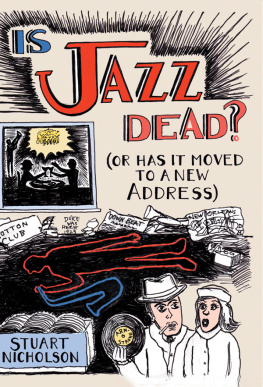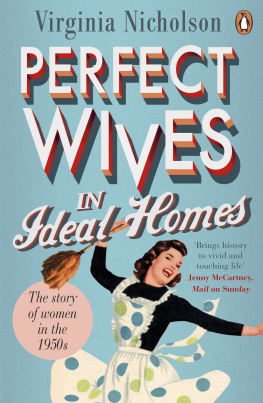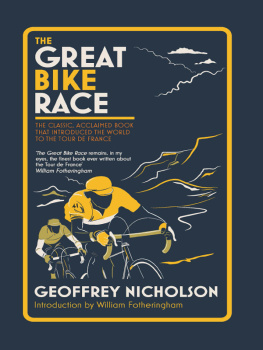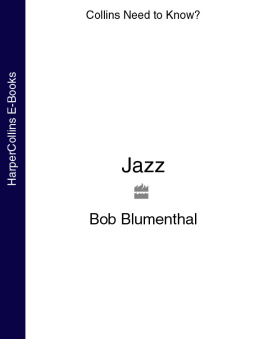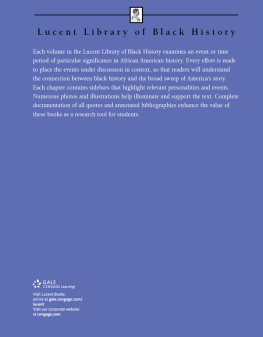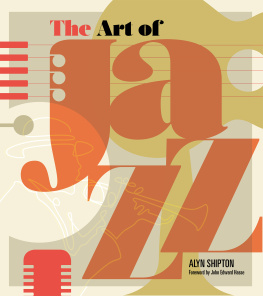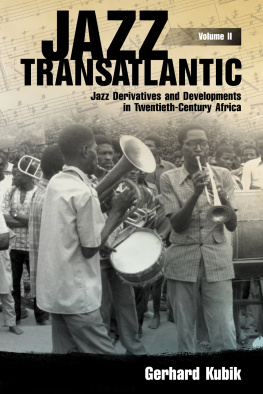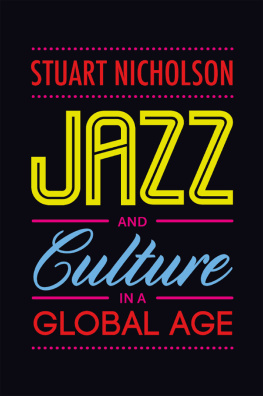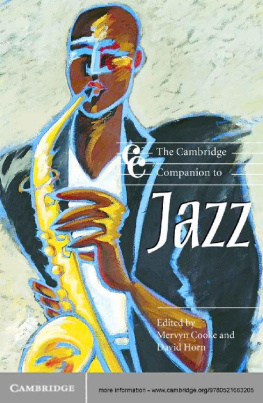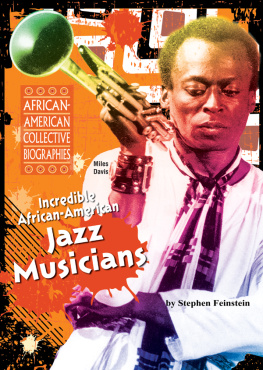Is
Jazz
Dead?
Is
Jazz
Dead?
(Or has it moved
to a new address)
STUART NICHOLSON

All citations are from the authors personal interviews and/or email conversations, unless otherwise noted.
Published in 2005 by
Routledge
Taylor & Francis Group
270 Madison Avenue
New York, NY 10016 | Published in Great Britain by
Routledge
Taylor & Francis Group
2 Park Square
Milton Park, Abingdon
Oxon OX14 4RN |
2005 by Taylor & Francis Group, LLC
Routledge is an imprint of Taylor & Francis Group
Printed in the United States of America on acid-free paper
10 9 8 7 6 5 4 3 2 1
International Standard Book Number-10: 0-415-96708-2 (Hardcover) 0-415-97583-2 (Softcover)
International Standard Book Number-13: 978-0-415-96708-2 (Hardcover) 978-0-415-97583-4 (Softcover)
Library of Congress Card Number 2005024395
No part of this book may be reprinted, reproduced, transmitted, or utilized in any form by any electronic, mechanical, or other means, now known or hereafter invented, including photocopying, microfilming, and recording, or in any information storage or retrieval system, without written permission from the publishers.
Trademark Notice: Product or corporate names may be trademarks or registered trademarks, and are used only for identification and explanation without intent to infringe.
Library of Congress Cataloging-in-Publication Data
Nicholson, Stuart.
Is jazz dead? : (or has it moved to a new address) / by Stuart Nicholson.
p. cm.
ISBN 0-415-96708-2 (hardback : alk. paper) - ISBN 0-415-97583-2 (pbk. : alk. paper)
1. JazzHistory and criticism. I. Title.
ML3506.N5 2005
781.6509051dc22 |
2005024395 |
 | Visit the Taylor & Francis Web site at
http://www.taylorandfrancis.com
and the Routledge Web site at
http://www.routledgeny.com |
To Dr. Elizabeth Peterson
CONTENTS
The globalization of jazz is not just another engaging story, another sign of the musics growing acceptance. To my mind it is the main story, the overwhelming trend, the key evolutionary thread taking us to the musics future.
Ted Gioia, musician and author of The History of Jazz
and West Coast Jazz
Jazz in the new millennium is in a very different world than that which was so lovingly re-created in the Ken Burns television retrospective Jazz. The reason is simple: It is competing for the leisure dollar in a highly competitive marketplace. Pop music, promoted with ruthless efficiency by the major corporations, dominates the cultural spaces. Jazzs voice is struggling to be heard.
So whats new? Hasnt jazz always jostled with consumer and popular culture for the publics attention throughout its history? Of course it has, but the early millennium years presented a very different music marketplace than that of the 1980s or even the 1990s. A once chaotic music industry, with an ever-changing array of music labels with names like Chess, Motown, Island, and Creation that were once as anarchic as the music itself, has hardened into an immovable oligarchy of EMI, Time-Warner, Universal, and Sony/BMG. As the number of majors shrank to these four players, the number of international superstars was also downsized, enabling the corporations to focus their efforts on promoting a smaller number of people more effectively. Their success can be measured by the ubiquity of these stars on the record charts and in the media, television, radio, and the Internet, and is a triumph of the corporate marketing machine. The increasing, homogenizing effect of the majors was reinforced by the deregulation of the airwaves that allowed companies like Clear Channel Communications, with more than 1,200 stations, to dominate the airwaves, which critics claim contributes to the growing bland-ness of broadcast music.
So where does an art form like jazz figure in a corporate jungle like this? Unprotected from market forces in the United States by public subsidy, it is fighting an unequal battle for survival. Jazz is at the mercy of a market that exerts its own disciplines, which can result in the music being shaped by commercial imperatives rather than aesthetic logic. This can take many forms, from an innocent request by a record producer to include a track by a jazz vocalist on an otherwise instrumental album to a kind of natural selection where promoters and club owners stick with a specific style they think the public wants (which is often an idealized representation of jazz from the 1950s or 1960s) to the exclusion of more experimental styles. If musicians dont want to play by the rules of supply and demand, then there is no shortage of those who will. A music that was founded in spontaneity and self-expression is in danger of ending up at the core of an ever more standardized world.
The inevitable homogenizing effects of the market take many forms, which I have tried to explore in this book, and they have contributed to the rise of an American mainstream that dominates current jazz practice. Those who do not broadly adhere to its conventions risk claims they are not playing jazz at all the real jazz that swings and alludes to the blues. This overwhelming legacy of the music exerts a powerful influence on how the music is shaped today, as exemplified in the music of Wynton Marsalis and in the ethos of Jazz at Lincoln Center. Meanwhile, a group of retro-styled singers have gained increasing popularity by imitating the sounds and styles of the great pop vocalists of the past. In the minds of many members of the public at large, and even some musicians, jazz today has come to represent the past rather than the present. This has been the cause of considerable controversy within the music. The terms of this debate pit the so-called neo-classicists, who insist on the priority of tradition and draw their inspiration and identity from a sense of connectedness with the historical jazz past, against both the continuous revolution of the avantgarde and the commercial orientation of fusion, wrote educator Scott DeVaux in his essay Constructing the Jazz Tradition. I suggest this debate goes even further, to include styles influenced by so-called World Music and glocalized styles of music from around the world.
A continuing theme throughout jazz history has been the use of appropriation that reveals a continuing dialogue not only with popular culture but other musical forms to broaden the scope of jazz expression. The culture of jazz is based on change because that is the culture of American: If a product or enterprise does not keep reinventing itself, it is swept aside by something that does. That is why it is vital for jazz musicians, as they have in the past, to keep their lines of input open to appropriate whatever is around them today, whether it be computer technology, sound processing tools and so on, or whatever, in order to continue the historic task of broadening the expressive base of the music. Some musicians are reinvig-orating the music and keeping it relevant to todays audiences, but they are struggling to be heard. Because little has been written about these developments, the time seemed right to attempt to contextualize these new innovators within the continuing narrative of jazz history.
This book attempts to examine some of the tensions in todays jazz scene. Reading through the drafts, I realize that I have made a recurring argument for public subsidy to support the music. I am more than ever convinced that the music cannot survive without the injection of public money to a greater or lesser degree. If this sounds like a plea to governments of all stripes everywhere to support this valuable art form, then you are right; it is. Art and commerce seldom mix, and at this point in the history of the music, the need for funding has never been more acute. Its pretty rough here, theres no jazz middle class, you either play at Lincoln Center or the Iridium for people dining, or you play at Tonic for the door, said drummer and composer Bobby Previte told me in 2003. I think its really harder for younger people than it was when I first came to New York [in the early 1980s], and it was hard then! I dont know how they do it. The issue of the elimination of the midrange gig is something that is explored in the broader context of jazz funding in the United States.

